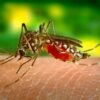Women whose household drinking water contained nitrate had babies that weighed, on average, 10 grams less than babies born to mothers where household water had no detectible nitrate, according to a new study from researchers at the University of Illinois Chicago and Aarhus University.
The study, which is published in the journal Environmental Health Perspectives, followed pregnant women living in Denmark. The researchers found that even low nitrate levels—about half of the allowable level set by the U.S. Environmental Protection Agency, or EPA—caused an adverse effect.
“While the effects of elevated nitrate levels on infant health are known, little research has been done on the impact of lower levels of nitrate in drinking water may have on neonates,” said Vanessa Coffman, UIC visiting research specialist at the School of Public Health and lead author on the paper. “This is a critical data gap if we want to assess the adequacy of our current water standards for nitrate.”
Drinking water becomes contaminated by nitrate when fertilizers seep into drinking water sources. High levels of nitrate in tap water can cause infant methemoglobinemia—a potentially fatal condition known as blue baby syndrome in which a baby’s skin turns blue—as nitrate prevents hemoglobin in the blood from carrying oxygen. For this reason, the EPA set standards for nitrate in drinking water at 10 parts per million, to reduce the risk of blue baby syndrome. In Denmark, the allowable level of nitrate in drinking water is similar.
In the largest study of the association between nitrate in drinking water and birth weight, Coffman and colleagues estimated maternal nitrate exposure for 852,348 live births in Denmark from 1991 to 2011. They linked home addresses with nitrate data from a national water quality monitoring database with data from Danish registries on infant birth weight, length and head circumference—these registries offer an unparalleled resource for epidemiologists, as they are some of the most complete in the world, with national health care data and robust individual demographics and environmental data spanning decades.
The researchers found that levels of nitrate in maternal drinking water were associated with birth weight, but the weight differences were small but important. Babies born to mothers whose drinking water was estimated to contain about half of the allowable level of nitrates were on average 10 grams lighter than babies born to households where drinking water nitrate levels were undetectable. The researchers also observed a decrease in body length with increasing nitrate concentrations in drinking water. No effect was observed on head circumference.
“This difference in weight and body length is small but could have an impact on health if the baby is underweight to begin with for other reasons. Birthweight is a critical marker for health, as it can have a life-long impact on health and development,” Coffman said.
Largest-ever study to look at maternal nitrate consumption and birth outcomes
More information:
Vanessa R. Coffman et al, Prenatal Exposure to Nitrate from Drinking Water and Markers of Fetal Growth Restriction: A Population-Based Study of Nearly One Million Danish-Born Children, Environmental Health Perspectives (2021). DOI: 10.1289/EHP7331
Provided by
University of Illinois at Chicago
Citation:
Nitrate in maternal drinking water may impair fetal growth (2021, February 9)
retrieved 9 February 2021
from https://medicalxpress.com/news/2021-02-nitrate-maternal-impair-fetal-growth.html
This document is subject to copyright. Apart from any fair dealing for the purpose of private study or research, no
part may be reproduced without the written permission. The content is provided for information purposes only.



